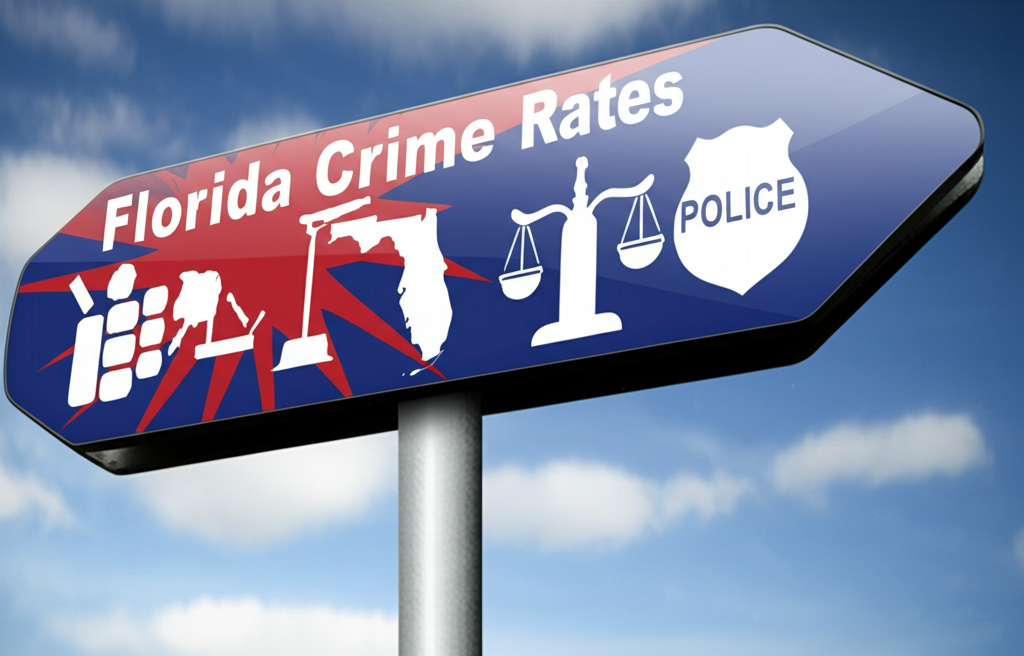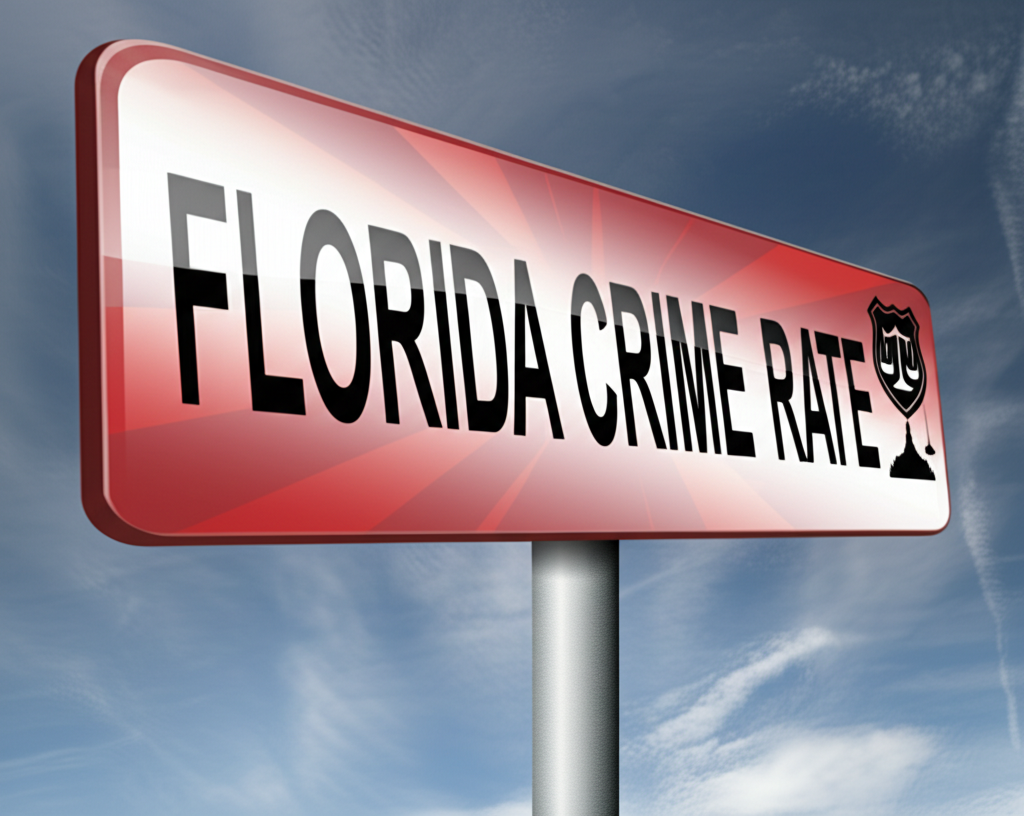Florida Crime Rate: A Comprehensive Analysis of Violent and Property Crimes

Florida Crime Rate’s Overview
Understanding crime patterns in Florida starts with the basics. The state’s crime statistics reveal a mix of challenges and progress, shaped by factors like population density and law enforcement strategies. While headlines often focus on high-profile incidents, the data tells a broader story about safety across urban and rural areas.
- Florida’s overall crime rate stands at 18.07 incidents per 1,000 residents, totaling 408,486 reported cases annually
- Violent crime occurs at a rate of 2.90 per 1,000 residents—lower than the national median of 4.00
- Property crime accounts for most reports, with a rate of 15.16 per 1,000 residents
- Hotspot areas drive the state’s crime density (40 per square mile), surpassing the national average
| Location | Crimes Per Square Mile |
|---|---|
| Florida | 40 |
| National Median | 26.5 |
Violent Crime Statistics in Florida

Florida’s violent crime trends show both progress and persistent challenges. According to the latest Uniform Crime Reports, the state’s rate of 2.90 incidents per 1,000 residents sits below the national median of 4.00. Breaking this down, assault dominates the numbers, accounting for over 73% of all violent crime cases. While murder rates (0.05 per 1,000) remain slightly lower than the U.S. average, certain offenses like robbery (0.42) and rape (0.30) show room for improvement compared to national figures.
- Florida’s violent crime rate is 2.90 per 1,000 residents, below the national median of 4.00
- Residents have a 1 in 345 chance of experiencing violent crime
- Assault is the most common type, making up 2.13 incidents per 1,000 people
- Murder rates are slightly lower than the national average at 0.05 per 1,000
| Crime Type | Florida Rate (per 1,000) | U.S. Rate | Florida Total (2023) | U.S. Total |
|---|---|---|---|---|
| Murder | 0.05 | 0.06 | 1,066 | 19,252 |
| Rape | 0.30 | 0.38 | 6,755 | 127,216 |
| Robbery | 0.42 | 0.67 | 9,564 | 222,795 |
| Assault | 2.13 | 2.64 | 48,236 | 884,550 |
Property Crime Statistics in Florida

Florida’s property crime landscape shows some encouraging trends while highlighting areas needing attention. Recent crime statistics from the Uniform Crime Reports reveal a rate of 15.16 incidents per 1,000 residents – significantly lower than the national median of 19.00. Theft dominates these numbers, making up 12.21 cases per 1,000 people and accounting for over 80% of all property crime reports. While burglary (1.63 per 1,000) and motor vehicle theft (1.32) rates remain below U.S. averages, these figures still translate to thousands of affected households statewide.
- Florida’s property crime rate of 15.16 per 1,000 residents trails the national median of 19.00
- Residents have a 1 in 66 chance of experiencing property crime
- Theft accounts for 12.21 incidents per 1,000 people – nearly 7 times more than burglary
- Motor vehicle theft rates sit at less than half the national average
| Crime Type | Florida Rate (per 1,000) | U.S. Rate | Florida Total (2023) | U.S. Total |
|---|---|---|---|---|
| Burglary | 1.63 | 2.51 | 36,874 | 839,563 |
| Theft | 12.21 | 13.47 | 276,181 | 4,512,064 |
| Motor Vehicle Theft | 1.32 | 3.19 | 29,810 | 1,067,522 |
Crime Density in Florida

While Florida’s per-person crime statistics remain below national averages, its crime density tells a different story. The state records 40 criminal incidents per square mile – over 50% higher than the U.S. median of 26.5. This contrast between lower per-capita rates and higher geographic concentration highlights unique challenges for law enforcement and communities. Urban hubs like Miami and Tampa drive this pattern, where dense populations and tourist activity create hotspots for both property offenses and violent crimes.
- Florida’s crime density (40/sq mi) far exceeds the national median of 26.5
- Population clusters in cities and coastal areas intensify social issues related to crime
- Tourist destinations see seasonal spikes in theft and fraud cases
- Law enforcement strategies focus on high-density zones through targeted patrols
Top Ten Safest Cities in Florida

Overall crime rate varies across regions, some communities stand out for exceptional public safety. These cities combine lower population density, proactive law enforcement, and community engagement to create safer environments. Below are the top ten cities where residents experience fewer criminal incidents compared to statewide averages.
- Brooker leads as Florida’s safest city, with crime rates 85% below state averages
- Smaller populations in these areas allow law enforcement to focus on preventive measures
- Many safest cities prioritize neighborhood watch programs to boost public safety
- Low tourism traffic in these areas reduces opportunities for property crimes
| Rank | City |
|---|---|
| 1 | Brooker |
| 2 | Worthington Springs |
| 3 | Day |
| 4 | Horseshoe Beach |
| 5 | Morriston |
| 6 | Caryville |
| 7 | Raiford |
| 8 | Seville |
| 9 | Nobleton |
| 10 | Ochopee |
Popular Cities in Florida and Their Crime Rates

Florida’s popular cities attract millions of residents and visitors, but their crime rate profiles vary widely. While the state’s overall violent crime and property crime rates sit below national averages, urban areas often face unique challenges due to population density and tourism. Below is a look at how well-known cities fit into Florida’s broader crime statistics, with data sourced from law enforcement reports via FDLE and the FBI’s Uniform Crime Reporting program.
- Tourist hubs like Miami and Orlando often see higher property crime rates due to crowded areas
- Law enforcement in cities such as Tampa uses targeted patrols to address neighborhood-specific risks
- Jacksonville, Florida’s largest city by population, balances urban challenges with community safety initiatives
- Smaller popular cities like Port St. Lucie benefit from lower crime density compared to metro areas
| Popular Cities |
|---|
| Cape Coral |
| Fort Lauderdale |
| Gainesville |
| Hialeah |
| Hollywood |
| Jacksonville |
| Miami |
| Miramar |
| Orlando |
| Palm Bay |
| Pembroke Pines |
| Port St. Lucie |
| St. Petersburg |
| Tallahassee |
| Tampa |
Crime Data Methodology

Understanding how crime statistics are collected helps explain their accuracy and limitations. The methodology behind Florida’s crime data relies on collaboration between local law enforcement and national agencies like the FBI. Reports follow the Uniform Crime Reports system, which standardizes categories such as violent and property crimes for fair comparisons across states.
- Data is sourced from 18,000 local law enforcement agencies across the U.S., ensuring a wide coverage of incidents
- Numbers reflect the 2023 calendar year and are updated annually by the FBI for consistency
- A nationwide meta-analysis of 9.4 million reported crimes supports trend identification and regional comparisons
Additional Insights on Florida Crime Rates
While Florida’s crime rate comparison shows lower numbers than national averages, its crime density tells a different story. The state’s unique geography and population distribution create hotspots that impact public safety perceptions. Collaboration between residents and law enforcement plays a key role in addressing these patterns.

- Florida’s crime rates for both violent and property crimes are below the national median, with violent crime rates at 2.90 per 1,000 residents versus the U.S. median of 4.00
- The state’s crime density is higher than the national average (40 vs. 26.5 crimes per square mile), suggesting clustered incidents in urban areas
- Brooker is ranked as the safest city in Florida, followed by smaller communities like Worthington Springs and Day
| Metric | Florida | National Median |
|---|---|---|
| Crime Density (per sq. mile) | 40 | 26.5 |
Understanding the Impact of Crime on Florida Communities

Crime doesn’t just shape statistics—it directly influences daily life. In Florida, the crime impact stretches beyond safety concerns, affecting schools, local businesses, and neighborhood trust. While violent crime rates here are lower than national averages, the state’s higher crime density means some areas feel these effects more intensely. This uneven distribution often ties into broader social issues, such as economic inequality or limited access to resources.
- Crime affects public safety, economic development, and quality of life in Florida communities, with property crimes like theft costing residents millions annually
- Law enforcement and local groups prioritize community policing to build trust and address neighborhood-specific risks
- Investments in youth programs and addiction services aim to tackle root causes of crime, complementing traditional public safety strategies
| Crime Type | Florida Rate (per 1,000) | Impact Focus |
|---|---|---|
| Violent Crime | 2.90 | Safety perceptions, mental health |
| Property Crime | 15.16 | Economic strain, insurance costs |
Conclusion
In conclusion, the comprehensive analysis of Florida’s crime rates, encompassing both violent and property crimes, reveals a complex landscape shaped by various factors including population density, law enforcement strategies, and social issues. Despite Florida’s violent crime rate being below the national median, the state faces unique challenges due to its higher crime density, particularly in urban areas.
Property crimes, notably theft, dominate the crime statistics, underscoring the need for continued focus on preventive measures and community engagement. The data, sourced from the Uniform Crime Reports and law enforcement agencies, highlights the importance of addressing the root causes of crime through targeted interventions and public safety initiatives.
As Florida continues to navigate these challenges, the collaboration between law enforcement, communities, and policymakers will be crucial in fostering a safer environment for all residents.



